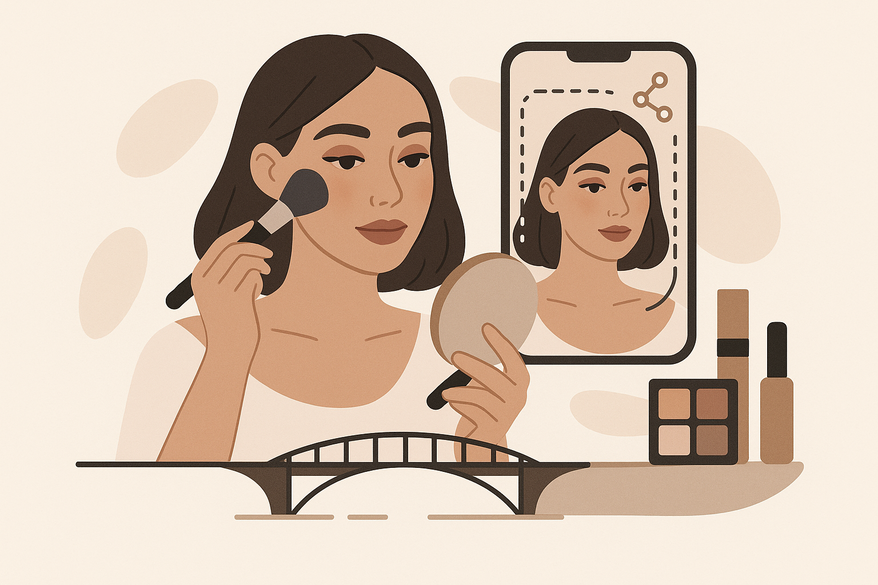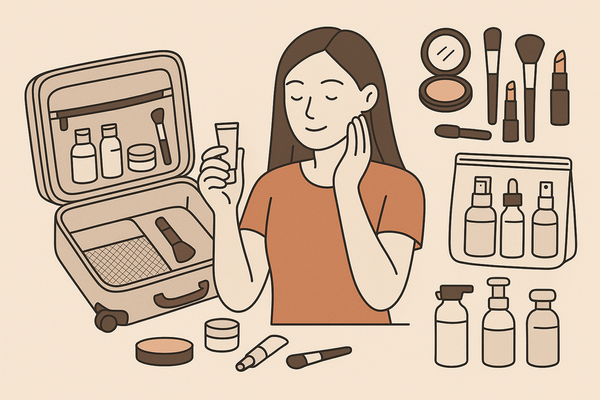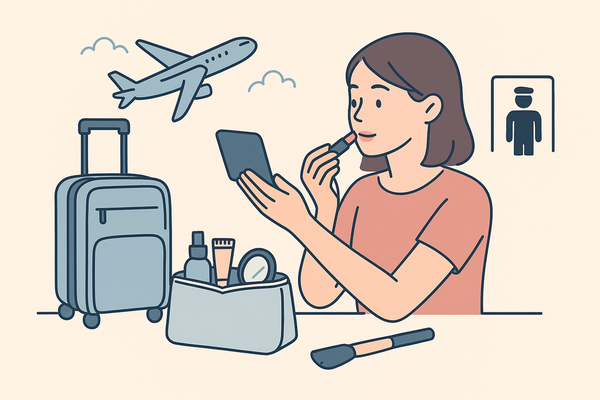Selfie vs Real Life Makeup: Bridging the Gap with AI Makeup Generator
Explore how AI makeup generators can help bridge the gap between selfie and real life makeup, enhancing your beauty routine both online and offline.

Estimated reading time: 8 minutes
Key Takeaways
- Selfie makeup exaggerates features for 2D photos, whereas real-life makeup focuses on subtlety.
- Lighting, camera angles, and filters create a paradox between on-screen and in-person looks.
- AI makeup generators analyze facial landmarks to provide realistic, customizable virtual trials.
- Combining traditional techniques with AI tools saves time, reduces waste, and boosts creativity.
- Practical tips and recommended apps help you achieve makeup that shines both on-screen and off.
Table of Contents
- Section 1: The Makeup Paradox: Selfie vs Real Life Makeup
- Section 2: The Impact of Technology on Selfie vs Real Life Makeup
- Section 3: Spotlight on AI Makeup Generator
- Section 4: Practical Tips for Selfie vs Real Life Makeup
- Conclusion
Section 1: The Makeup Paradox: Selfie vs Real Life Makeup
Defining the Two Styles
- Selfie makeup: Heavy contour, bold eyeshadow, over-lined lips—designed to make features stand out in flat, 2D photos.
- Real life makeup: Subtle color matching, seamless blending, natural highlights—suited to varied lighting and three-dimensional depth.
Lighting Effects on Appearance
- Ring lights diffuse light uniformly, minimizing shadows and softening blemishes for ultra-even skin in selfies.
- Ambient or natural light reveals texture and uneven blending, making heavy makeup look cakey or harsh.
Camera Angles & Lens Distortion
- Wide-angle selfie lenses sit close to the face, enlarging the nose and flattening cheeks.
- To counter distortion, many over-contour; but that contour often appears too stark in person.
Filters & Digital Editing
- Skin-smoothing filters erase pores and fine lines; color-boost filters enhance lip and cheek pigments.
- AR makeup overlays let you “try on” neon liner or glitter gloss—results impossible to fully replicate with real-world products. See our virtual try-ons.
Surface vs. Depth in Imaging
- A smartphone camera captures a 2D snapshot, flattening the face and hiding subtle shadows.
- In real life, light and shadow define bone structure and texture; you need softer blending and gradual build-up for a natural look.
Common Myths & Misconceptions
- Myth: Flawless selfie makeup = flawless in person. Reality: Digital tools hide imperfections you can’t erase with powder alone.
- Myth: The heavier the contour, the better on camera. Reality: Too much product reads as mask-like under most indoor lighting.
Section 2: The Impact of Technology on Selfie vs Real Life Makeup
Digital Preview & Editing Tools
The beauty industry has embraced apps and software that let users tweak makeup in real time. These tools:
- Offer live-view adjustments of foundation shade, blush intensity, and brow color.
- Encourage experimentation with bold palettes, sharper lines, and graphic details.
- Push mainstream trends toward more vibrant, exaggerated looks—since users get instant camera feedback.
Rise of AI in Beauty Innovation
AI algorithms now analyze facial landmarks—eyes, lips, cheekbones—and recommend customized makeup styles. This data-driven approach:
- Identifies undertones, skin texture, and unique features.
- Suggests products and application techniques for both on-camera and in-person wear.
- Lays the groundwork for the AI makeup generator, a next-gen digital trial tool that bridges the selfie-real life divide.
Tools like Makeup Check AI harness AI to let you preview makeup looks under different lighting presets, reducing the guesswork between selfies and real life. For a quick demonstration on how it works, watch the overview video below:
Section 3: Spotlight on AI Makeup Generator
Defining AI Makeup Generator
An AI makeup generator is software that uses facial landmark detection, machine learning models, and digital artistry to overlay realistic makeup on images or live video.
How It Works (Step-by-Step)
- User uploads a selfie or enables live streaming.
- The algorithm maps facial landmarks (tip of nose, brow arch, lip borders).
- Digital brushes apply virtual foundation, contour, blush, eyeshadow, and lip color.
- Real-time preview cycles through lighting presets (ring light, daylight, tungsten).
Use Cases & Comparisons
- Side-by-side previews: camera-optimized selfie vs subtle real-life version.
- Risk-free play with neon eyeliners, dramatic brows, or monochrome eyeshadow.
- Quick comparison helps you decide if a look works off-screen.
Benefits of AI Makeup Generator
- Saves time and reduces product waste—no more buying full palettes to test one shade.
- Encourages creative risk-taking—experiment with avant-garde styles with zero mess.
- Increases accessibility—novices get guided trials before committing.
- Educates on feature enhancement—see how subtle tweaks transform your face shape.
Potential Limitations
- Digital-to-physical mismatch—real pigments and skin undertones vary from screen renderings.
- Accuracy hinges on image quality and stable lighting; poor uploads yield flawed mapping.
- Risk of unrealistic expectations—perfect digital skin can disappoint when matched in reality.
Section 4: Practical Tips for Selfie vs Real Life Makeup
Achieving Dual-Purpose Makeup
- Build a seamless base: use a damp sponge to achieve light, even coverage.
- Moderate contour: apply in natural daylight, then soften edges for everyday wear.
- Adaptable eyes: choose shades that transition from camera-friendly vibrance to soft natural in person.
- Test under three lighting conditions: bright daylight, warm indoor light, and ring light (to preview camera effect—see our ultimate selfie lighting makeup tips).
Recommended Apps & Tools (AI Makeup Generator)
- YouCam Makeup – Virtual try-ons and AI style suggestions
- Facetune – Color adjustments and skin-smoothing filters
- Instagram AR Filters – Quick, on-the-fly previews for camera-ready looks
Tips for Makeup Artists & Enthusiasts
- Integrate AI makeup generators into client consultations: let clients preview looks on their own selfies.
- Use AI before/after snaps to demonstrate how filters alter perception vs. real life.
- Highlight cross-medium techniques: defined brows, clean winged liner, and diffused cheek color read well both on camera and off.
Conclusion
Understanding the selfie vs real life makeup paradox helps you craft looks that translate under ring lights, filters, and natural daylight. Differences in lighting, camera angles, digital editing, and 2D flattening explain why heavy contour or bold colors often fall flat in person.
AI tools—especially the AI makeup generator—are closing the gap. They let you preview camera-ready styles and adjust intensity for in-person wear. By combining time-tested blending and color-matching techniques with AI experimentation, you can create versatile makeup that shines both on-screen and off.
Call to Action
Ready to level up your beauty routine? Download an AI makeup generator app today and start blending traditional techniques with cutting-edge tech. Discover looks that make you look and feel your best, everywhere you go.
FAQ
- What is the main difference between selfie and real-life makeup?
Selfie makeup uses bold lines and heavy products for 2D photos, while real-life makeup focuses on natural blending and adaptability to varied lighting. - How does an AI makeup generator work?
It maps facial landmarks, applies digital makeup layers, and cycles through lighting presets to simulate on-camera and in-person looks. - Can digital trials really match physical products?
They offer a close preview, but screen renderings may differ from actual pigments and skin undertones. Always test in person before finalizing. - Which apps offer the best virtual try-ons?
Top picks include YouCam Makeup, Facetune, and Instagram AR Filters. - How can I ensure my makeup works both on camera and off?
Use moderate contour, blend in natural light, test under multiple lighting scenarios, and leverage AI previews to fine-tune your look.




